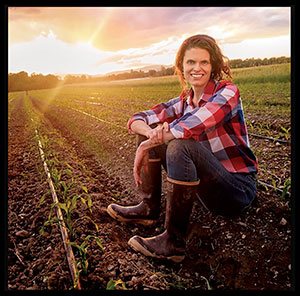Something strange and troubling is sweeping the fields of New Morning Farm in South Central Pennsylvania. Over the past few years, Jim Crawford has watched unfamiliar diseases strike at the 40 acres of organic vegetables he grows, destroying some crops entirely. Last year was the worst of his 45 years farming: Crawford finished $60,000 in the red. He’s not confident this year will be much better. It was a wet, humid summer, and the moisture incubated blight.
When Crawford was new to farming, he remembers, he’d open up local newspapers to see five, eight, even 10 ads at a time for farms that were going out of business. America has lost 4 million farms since 1935, though the amount of land used for agriculture has stayed about the same—operations just keep getting bigger. Crawford survived at first on idealism, and then by founding a wholesale cooperative and adopting a direct-marketing system to sell directly to residents of the Washington, DC, area. The small farm settled into a lean, but stable, equilibrium. Then came new diseases and pests, some that even a university lab couldn’t identify. Crawford wonders if they’re related to climate change. “We’re at a point ourselves of really questioning, can we keep going? Losing this kind of money, we can’t,” Crawford said recently. He’ll give it another year, with a new crop mix—but if that doesn’t work, who knows? “That just goes to show how unpredictable and risky what we do is,” he said.
It’s a time of deep uncertainty at every link in the global food chain. For the first time in a decade, the number of hungry and malnourished people in the world is rising. Climate change threatens breadbasket regions the world over. Nestlé and other multinational food companies peddle processed foods deeper into remote areas of Latin America, Africa, and Asia, igniting debate about whether they’re feeding hungry communities or making them sick; globally, deaths from diet-related illnesses are rising. The malnutrition of the future, as predicted by a recent New York Times report, is to be “both overweight and undernourished.”
Meanwhile, the corporations that produce seeds, process meat, and sell the final products back to us gobble each other up. In the mid-1970s, America’s four largest meatpacking companies controlled about a quarter of the beef market; today the top four control a staggering 84 percent. With antitrust regulators asleep on the job, extreme consolidation across the agriculture sector means farmers pay more for inputs like seeds and earn less for their own products. And as companies like Monsanto get bigger, so does their political clout, which affects not only what we eat but also public health.
Popular
"swipe left below to view more authors"Swipe →
Our social and political anxieties spill over at the dinner table. Cities in Italy and France flirt with bans on street food made primarily by migrants. Right-wing nationalists in India have weaponized a taboo against eating beef. Our current president eats a taco bowl to communicate his “love” for Hispanics and then, months later, oversees a crackdown on the immigrants who grow, pick, cook, and serve America’s food.
To say that the future of food will be high-tech tells us little about the values of the food system we’re building for future generations. Will targeted genome-editing tools like CRISPR lead to hardier, more nutritious plants, or will they enrich agrochemical corporations at the expense of farmers and the environment? Consider the food-tech start-up Juicero, maker of a $400 machine to cold-press fresh produce packets available by delivery—an idea that greatly excited investors, until someone discovered that you could simply squeeze the packets by hand. In the dystopian future foreshadowed by Juicero, the wealthy will pay, via one-click ordering, for expensive and unnecessary gadgets to prepare and deliver their food, while those without money will eat… cake?
But other projects and innovations point to a different kind of future, creating crops that regenerate the soil they’re grown in and worker organizations that fight exploitation right down the supply chain. Sapped rural economies will become regional food hubs. The rituals of cooking and eating will draw communities closer together. Of course, none of that will happen easily. “Not everyone is going to be able to buy food at the farmer’s market or become members of a CSA. So our challenge is to build in our values at all the other places where people get food,” says Sarah Lloyd, a dairy farmer who also works for the Wisconsin Farmers Union and the Wisconsin Food Hub Cooperative. “We’re going to need to do that very intentionally, because the markets are not going to do that themselves.” So how do we get to a more equitable and sustainable food system? That’s the question we asked our forum participants, who offer their answers below.
—Zoë Carpenter
The Other NRA
by Saru Jayaraman
A s restaurant-worker organizers, we’ve been pushing back for many years against the outsized power of the National Restaurant Association, what we call “the other NRA.” This NRA has lobbied successfully to keep the minimum wage for tipped workers at $2.13 an hour. This wage is a legacy of slavery; after Emancipation, the restaurant industry of the post–Civil War era lobbied to hire newly freed slaves, pay them literally nothing, and force them to live on customer tips. The wage has increased from $0 to $2.13 over the last century. This ridiculously low minimum wage is the reason that the restaurant industry, with over 14 million workers, remains the lowest-paying sector of the US economy despite being one of the fastest-growing. Moreover, more than two-thirds of tipped workers are women. Female tipped workers suffer from economic instability and must tolerate sexual harassment from customers in order to feed their families on their tips. After the 2016 election, many news reports featured interviews with frustrated and disillusioned restaurant workers who had voted for Donald Trump; many more millions of restaurant workers did not vote at all.
 We’ve been pushing back against the other NRA through One Fair Wage, our campaign to raise the minimum wage and to eliminate altogether the scandalously low minimum wage for tipped workers. We were able to work with supportive restaurant owners like Danny Meyer, leading to hundreds of restaurants following suit. We’ve had victories like passing One Fair Wage legislation in Maine and in cities like Flagstaff, Arizona. But with every victory, the NRA has poured millions more dollars into maintaining the status quo.
We’ve been pushing back against the other NRA through One Fair Wage, our campaign to raise the minimum wage and to eliminate altogether the scandalously low minimum wage for tipped workers. We were able to work with supportive restaurant owners like Danny Meyer, leading to hundreds of restaurants following suit. We’ve had victories like passing One Fair Wage legislation in Maine and in cities like Flagstaff, Arizona. But with every victory, the NRA has poured millions more dollars into maintaining the status quo.
The NRA has partnered with Trump’s Labor Department to propose a new rule that would allow restaurant owners to legally take workers’ tips away from them if they pay them a full minimum wage. This proposal would overturn 80 years of regulation ensuring that tips belong to the workers they’re given to, and would personally benefit Trump by allowing his own restaurants to legally steal their employees’ tips.
This outrageous proposal presents the opportunity to mobilize thousands of workers, employers, and consumers—pretty much anyone who believes that tips belong to workers—and then move these thousands (including those who voted for Trump) to fight for what we really need, which is One Fair Wage. There have been several moments in history in which the corporate kleptocracy went too far, resulting in social movements that won transformative change. The Trump era could prove to be one of those moments.
The Problems With Fair Trade
by Raj Patel
True equality and sustainability can only be attained when we recognize where inequity and unsustainability come from. Consider something as simple as a banana. In the banana industry, workers are treated poorly: They’re exposed to dangerous pesticides and toil for low and uncertain wages. Fair-trade organic bananas offer a solution to this: no more pesticides (organic bananas!) and better pay for farmers.
 But a fair-trade label on bananas guarantees neither equity nor sustainability. Even when consumers pay more for the promise that farmers are getting a better-than-market price, the evidence of positive outcomes remains mixed. Fair trade only sometimes raises farmers’ incomes—and for migrant workers, protections are rare. Also, there is some evidence that fair trade deepens household gender inequality when farm families specialize in the cultivation of export-driven cash crops.
But a fair-trade label on bananas guarantees neither equity nor sustainability. Even when consumers pay more for the promise that farmers are getting a better-than-market price, the evidence of positive outcomes remains mixed. Fair trade only sometimes raises farmers’ incomes—and for migrant workers, protections are rare. Also, there is some evidence that fair trade deepens household gender inequality when farm families specialize in the cultivation of export-driven cash crops.
Most important, fair trade takes for granted that Latin America, the Caribbean, and other parts of the Global South ought to task themselves in perpetuity with growing our bananas. Fair trade doesn’t force us to confront how these countries became America’s fruit bowl.
For instance, more than one in three bananas on US store shelves come from Guatemala. When Guatemalan President Jacobo Árbenz tried in 1952 to inaugurate land reform for dispossessed peasants, the United Fruit Company was so concerned that it called its friends in the CIA, which initiated a coup that led to a 36-year civil war in which 200,000 people died—most at the hands of the brutal military and security services—and for which President Bill Clinton apologized in 1999. Nor was Guatemala the only case: The term “banana republic” was originally coined to describe Honduras and its neighbors, sovereign states dominated by American companies like United Fruit, backed by US military force.
Equity and sustainability demand more than a mere apology. Guatemala is among the world’s top 10 countries for long-term vulnerability to climate change, its economy battered by extreme weather, its coastline redrawn by rising seas. For true equity, the United States needs to recognize its debt with reparations—reparations for the many ways we continue to benefit from past horrors in the food system, both here and abroad.
There’s no magic number that we in the United States can put on this, no sufficient check to write. But surely it’s better to recognize how far back in time we need to go to accept responsibility for our actions, how deep that debt runs, and how inequity and unsustainability continue to mount under capitalism. To evade this long, hard reckoning is to ask for a very attenuated kind of equity and sustainability—the kind whose demands can be shrunk to fit on a label.
The New Face of Family Farms
by Lindsey Shute
If you want to disrupt the auto industry, you’d better have a few billion dollars: Mom-and-pop automakers are unlikely to outflank the Big Three. But in agriculture, small operators can outdo the major players. By connecting directly with customers, and by responding nimbly to changes in the markets as well as in their ecosystems, small farmers can keep one step ahead of the big guys. As the co-founder of the National Young Farmers Coalition and a family farmer myself, I have a front-row seat to the innovations among small farmers that are transforming the industry.
 For example, take the Quick Cut Greens Harvester, a tool developed just a couple of years ago by a young farmer, Jonathan Dysinger, in Tennessee, with a small loan from a local Slow Money group. It enables small-scale farmers to harvest 175 pounds of greens per hour—a huge improvement over harvesting just a few dozen pounds by hand—suddenly putting the little guys in contention with the mega-farms of California. Before the tool came out, small farmers couldn’t touch the price per pound offered by California farms. But now, with the combination of a better price point and a generally fresher product, they can stay in business.
For example, take the Quick Cut Greens Harvester, a tool developed just a couple of years ago by a young farmer, Jonathan Dysinger, in Tennessee, with a small loan from a local Slow Money group. It enables small-scale farmers to harvest 175 pounds of greens per hour—a huge improvement over harvesting just a few dozen pounds by hand—suddenly putting the little guys in contention with the mega-farms of California. Before the tool came out, small farmers couldn’t touch the price per pound offered by California farms. But now, with the combination of a better price point and a generally fresher product, they can stay in business.
The sustained success of small farmers, though, won’t happen without fundamental changes to the industry. One crucial factor is secure access to land. Competition from investors, developers, and established large farmers makes owning one’s own land unattainable for many aspiring new farmers. From 2004 to 2013, agricultural real-estate values doubled, and they continue to rise in many regions.
Another challenge for more than a million of the most qualified farmworkers and managers is a nonexistent path to citizenship—the ultimate barrier to building a farm of their own. With farm operators over the age of 65 outnumbering farmers younger than 35 by a margin of six to one, and with two-thirds of the nation’s farmland in need of a new farmer, we must clear the path for talented people willing to grow the nation’s food.
There are solutions that could light a path toward a more sustainable and equitable farm economy, but farmers can’t cobble them together in our barns. We at the National Young Farmers Coalition need broad support as we urge Congress to scale up farmland conservation, as we push for immigration reform, and as we pursue policies that will ensure the success of a diverse and entrepreneurial next generation of farmers from all backgrounds. With a new farm bill on the horizon in Congress, consumers must take a stand with young farmers.
Building a Small-Scale Farming Revolution
by John W. Boyd Jr.
As climate change continues to disrupt American life, we must pay attention to its effects on our food system and the farmers who support it. Special consideration is due to black farmers, who have endured greater burdens working the land, from slavery and sharecropping to discrimination and the fight for occupational justice. As a fourth-generation black farmer and activist, I strive to keep up with US Department of Agriculture updates on climate change. This issue has never been more relevant. Recent hurricanes like Harvey and Irma have demonstrated that we are not prepared for the effects of extreme weather events on farming. For many years on my Virginia farm, I had my corn crop in the ground by the end of March. But for a decade, my spring planting has been pushed back because of changes in the weather patterns. Nowadays, I find myself planting corn in May. To create an equitable, sustainable future for food access, we have to build a small-scale farming revolution.
 Given our centuries of expertise, black farmers are especially needed. Farming is our oldest occupation. In freedom, we treasured having land to work for ourselves, for our families, and for racial progress. “Forty acres and a mule” was a persistent aspiration. The average black-owned farm at the end of the 19th century was 50 acres. Nearly every black farmer had a mule—two if they were lucky. My grandfather, Thomas Boyd, owned a team of mules to provide labor and transportation. He had a piece of ground to work. Those were his family’s security.
Given our centuries of expertise, black farmers are especially needed. Farming is our oldest occupation. In freedom, we treasured having land to work for ourselves, for our families, and for racial progress. “Forty acres and a mule” was a persistent aspiration. The average black-owned farm at the end of the 19th century was 50 acres. Nearly every black farmer had a mule—two if they were lucky. My grandfather, Thomas Boyd, owned a team of mules to provide labor and transportation. He had a piece of ground to work. Those were his family’s security.
In my 30-plus years of advocacy, I have seen a crisis grow among white farmers and black farmers alike. But black farmers have it harder because we never gained equal means to fight off corporate domination. In a $1.25 billion settlement in 2010, the courts acknowledged that for decades, white male farmers were given preferential treatment in farm lending, loan servicing, and subsidies. Corporate farming has also taken the freedom out of farming. Huge companies like Monsanto and Bayer promote the use of genetically modified seeds. Farmers can no longer use the seeds from their crops to plant for next year.
Even as we strive to encourage a new generation to take up farming, time is against us; the average black farmer today is 62 years old. Meanwhile, the mega-agriculture companies may not be able to maintain food delivery during climate-change disasters. And we need more organic farmers producing healthy crops to feed America. Farming is hard work, but it is also a rewarding occupation. You may not need a doctor or lawyer every day, but every day you do eat food grown by farmers like us.
The Next Generation of GMOs
by Dana Perls
New genetic-engineering technologies like CRISPR are being sensationalized as “silver bullets” to address food-system challenges, from pollution to hunger. Similar promises were made about the first generation of genetically modified organisms (GMOs) in agriculture. Unfortunately, among other problems, most of these GMO crops led to massive increases in the use of toxic herbicides like glyphosate, a probable carcinogen. Before we embrace the next generation of GMOs, we need to understand their health, environmental, and social-justice effects. Unfortunately, the synthetic-biology industry is racing forward, fueled by hype and venture capital, with little regard for the possible consequences.
 Food products made with new GMO techniques include the meatless Impossible Burger, the GMO Arctic Apple, and vanilla flavoring derived from genetically engineered yeast. Some of these products are rapidly making their way onto our plates ahead of full safety assessments, regulations, and proper labeling (indeed, many of them are being marketed as “sustainable”). But the early evidence suggests that they may contribute more problems than solutions.
Food products made with new GMO techniques include the meatless Impossible Burger, the GMO Arctic Apple, and vanilla flavoring derived from genetically engineered yeast. Some of these products are rapidly making their way onto our plates ahead of full safety assessments, regulations, and proper labeling (indeed, many of them are being marketed as “sustainable”). But the early evidence suggests that they may contribute more problems than solutions.
Consider the Impossible Burger. FDA documents revealed that its key ingredient—the genetically engineered “heme” protein, which turns the burger red—may be an allergen, and also that there were 46 unexpected and unassessed proteins found in the product. The FDA stated that the studies submitted by Impossible Foods “do not establish the safety” of its product—and yet the company continues to sell these burgers across the country.
Evolva’s vanillin, from genetically engineered yeast fed with sugar and raised in vats, is being marketed as “natural and sustainable.” Evolva can do this because the term “natural” is legally undefined, allowing its product to compete with truly natural, plant-based vanilla, sustainably grown by 200,000 small farmers in rain forests in the Global South. As Alejandrino Garcia Castaño, a third-generation Mexican vanilla farmer, argues: “To put a ‘natural’ label on synthetic-biology products is a dishonest act”—one that “will hurt small-scale farmers who cultivate the real plant, while caring for real people and real forests.”
We are at a crossroads in the food system, and the direction we choose to take will have ripple effects far into the future. Do we want our food produced with risky, unregulated, patented, genetically engineered fungi or algae, fed with environmentally destructive feedstocks like GMO corn, and controlled by a handful of mega-corporations? Instead of investing in potential problems masquerading as solutions, shouldn’t we invest in the transparent, organic, humane, and socially just production of real food in a way that benefits farmers, food-chain workers, consumers, animals, and the environment?


